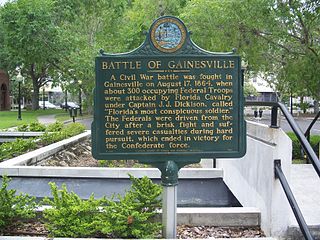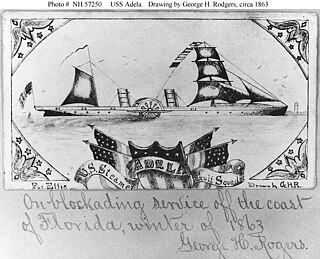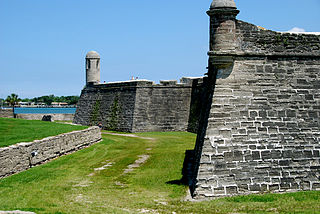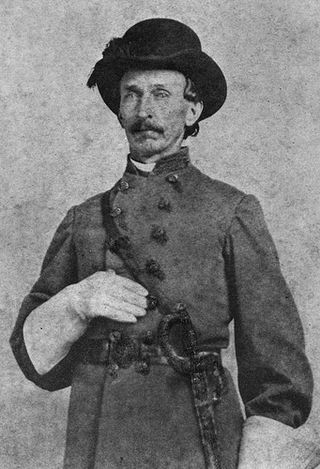
CSS Teaser had been the aging Georgetown, D.C. tugboat York River until the beginning of the American Civil War, when she was taken into the Confederate States Navy and took part in the famous Battle of Hampton Roads. Later, she was captured by the United States Navy and became the first USS Teaser.
The first USS Undine was a "tinclad" steamer in the United States Navy in 1864, during the American Civil War. She was captured on 30 October and put in service with the Confederates, but was not renamed before being burned, 5 days later, to prevent re-capture.

USS Albatross was a screw steamer rigged as a three-masted schooner acquired by the Union Navy during the beginning of the American Civil War. She was outfitted as a gunboat with heavy guns and used in the Union blockade of the waterways of the Confederate States of America.

The Battle of Gainesville was an American Civil War engagement fought on August 17, 1864, when a Confederate force defeated Union detachments from Jacksonville, Florida. The result of the battle was the Confederate occupation of Gainesville for the remainder of the war.

USS Marmora was a sternwheel steamer that served in the Union Navy from 1862 to 1865, during the American Civil War. Built in 1862 at Monongahela, Pennsylvania, as a civilian vessel, she was purchased for military service on September 17 and converted into a tinclad warship. Commissioned on October 21, the vessel served on the Yazoo River beginning the next month. She encountered Confederate naval mines on the Yazoo on December 11, and was present the next day when the ironclad USS Cairo was sunk by two mines. After further service on the Yazoo during the Battle of Chickasaw Bayou in late December, Marmora was assigned in January 1863 to a fleet that was preparing to operate against Confederate Fort Hindman, but was not present when the fort surrendered on January 11.

Florida participated in the American Civil War as a member of the Confederate States of America. It had been admitted to the United States as a slave state in 1845. In January 1861, Florida became the third Southern state to secede from the Union after the November 1860 presidential election victory of Abraham Lincoln. It was one of the initial seven slave states which formed the Confederacy on February 8, 1861, in advance of the American Civil War.

USS Norwich, a wooden, screw steamer built at Norwich, Connecticut in 1861, was purchased by the Union Navy at New York City 26 September 1861 from J. M. Huntington & Co.; and commissioned at the New York Navy Yard 28 December 1861, Lieutenant James M. Duncan in command.
The Battle of Marianna was a small but significant engagement on September 27, 1864, in the panhandle of Florida during the American Civil War. The Union destruction against Confederates and militia defending the town of Marianna was the culmination of a substantial Federal cavalry raid into northwestern Florida. Ultimately, the Union force withdrew to Fort Barrancas.

The Battle of Blair's Landing saw a Confederate cavalry-artillery force commanded by Brigadier General Tom Green attack several Union gunboats led by Rear Admiral David Dixon Porter and soldiers in river transports under Brigadier General Thomas Kilby Smith in Red River Parish, Louisiana. Green's force attempted but failed to stop the retreat of Porter's and Smith's forces downstream in an action that was part of the Red River Campaign of the American Civil War. The only significant casualty during the fighting was Green, who was killed by an artillery round.
The first USS Kingfisher was purchased by the Navy at Boston, Massachusetts, 2 August 1861; and commissioned at Boston Navy Yard 3 October 1861, Acting Lt. Joseph P. Couthouy in command.

USS Howquah was a screw steamer purchased by the Union Navy in Boston from G. W. Upton on 17 June 1863, for action against Confederate commerce raider CSS Tacony which was then preying upon Northern merchantmen during what Professor Richard S. West has called "the most brilliant daredevil cruise of the war."

USS Adela was a steamer captured by the Union Navy during the American Civil War. She was used by the Union Navy as a gunboat in support of the Union Navy blockade of Confederate waterways.

USS Tahoma was a Unadilla-class gunboat built by order of the United States Navy for service during the American Civil War.
USS T. A. Ward was a 284-ton schooner was purchased by the Union Navy during the Union blockade of the Confederate States of America during the American Civil War.

During most of the American Civil War the Florida city of St. Augustine was under Union control. Its Confederate history was exceedingly brief. One Union general and one Confederate general were natives of the Ancient City. Many officers on both sides had previous military experience in St. Augustine, particularly during the Second Seminole War. The city's historic Sea Wall was built in the 1830s, 1840s and 1850s by West Point engineers who went on to design military fortifications for both sides in the Civil War. Many black Union soldiers either came from St. Augustine, or settled there after the war, providing a leadership cadre for the community known as Lincolnville that was established in 1866. Many of the city's old cemeteries feature the distinctive marble tombstones marked "USCT" – United States Colored Troops.
Hispanics in the American Civil War fought on both the Union and Confederate sides of the conflict. Not all the Hispanics who fought in the American Civil War were "Hispanic Americans" — in other words citizens of the United States. Many of them were Spanish subjects or nationals from countries in the Caribbean, Central and South America. Some were born in what later became a U.S. territory and therefore did not have the right to U.S. citizenship. It is estimated that approximately 3,500 Hispanics, mostly Mexican-Americans, Puerto Ricans and Cubans living in the United States joined the war: 2,500 for the Confederacy and 1,000 for the Union. This number increased to 10,000 by the end of the war.

The Bahia incident was a naval skirmish fought in late 1864 during the American Civil War. A Confederate navy warship was captured by a Union warship in the Port of Salvador, Bahia, Brazil. The engagement resulted in a United States victory, but also sparked an incident between the United States and Brazil, over the American violation of Brazil's neutrality by illegally attacking a vessel in a Brazilian harbor.
Lola Sánchez (1844–1895) was one of three sisters who became spies for the Confederate Army during the American Civil War. Sánchez became upset when their father was falsely accused of being a Confederate spy by the members of the Union Army and imprisoned. Officers of the Union Army then occupied the Sánchez residence in Palatka, Florida. On one occasion Sánchez overheard various officers’ planning a raid and decided to alert the Confederates forces. She informed Captain John Jackson Dickison, commander of the local Confederates forces, of the plan. The result of her actions was that the Confederate forces surprised the Union troops in an ambush and captured the USS Columbine, a Union warship, on the day of the supposed raid in the "Battle of Horse Landing". This was one of the few instances in which a Union warship was captured by land-based Confederate forces during the Civil War.

John Jackson Dickison, known as J. J. Dickison, was an officer in the Confederate States Army during the American Civil War. Dickison is mostly remembered as being the person who led the attack which resulted in the capture of the Union warship USS Columbine in the "Battle of Horse Landing". This was one of the few instances in which a Union warship was captured by land-based Confederate forces during the Civil War and the only known incident in U.S. history where a cavalry unit sank an enemy gunboat. Dickison and his men were victorious in all of his raids against the Union troops in Florida, including his raid in Gainesville what is known as the Battle of Gainesville. Tragedy struck Dickison, when one of his sons, both of whom served under his command, was killed during a raid.

The 12th Texas Cavalry Regiment was a unit of mounted volunteers recruited in Texas that fought in the Confederate States Army during the American Civil War. The regiment was enrolled in state service in September 1861 and in Confederate service the following month. The regiment fought at Whitney's Lane, Cotton Plant, and L'Anguille Ferry in 1862, Goodrich's Landing in 1863, and Blair's Landing and Yellow Bayou in 1864. The unit also participated in numerous skirmishes and scouts. It disbanded in May 1865.













